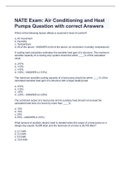Exam (elaborations)
SCRN study guide hyperacute care Questions with 100% Actual correct answers | verified | latest update | Graded A+ | Already Passed | Complete Solution
- Course
- Institution
SCRN study guide hyperacute care Questions with 100% Actual correct answers | verified | latest update | Graded A+ | Already Passed | Complete Solution
[Show more]




